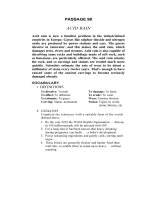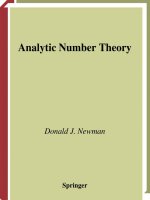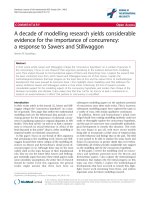Analytic Number Theory A Tribute to Gauss and Dirichlet Part 14 potx
Bạn đang xem bản rút gọn của tài liệu. Xem và tải ngay bản đầy đủ của tài liệu tại đây (403.88 KB, 6 trang )
252 H. M. STARK
in the case that |d|/a
2
is large. We can easily see where the two main terms come
from. We have
(5.1) ζ(s, Q)=
∞
m=1
(am
2
)
−s
+
∞
n=1
m
(am
2
+ bmn + cn
2
)
−s
.
We approximate the inner sum on the right by the integral,
∞
−∞
(at
2
+ bnt + cn
2
)
−s
dt = a
−s
|d|
2a
n
1−2s
∞
−∞
(u
2
+1)
−s
du .
The integral on the right evaluates to
∞
−∞
(u
2
+1)
−s
du =
√
πΓ(s −1/2)
Γ(s)
.
This gives the approximation,
ζ(s, Q)=a
−s
ζ(2s)+a
s−1
|d|
2
1−2s
√
πΓ(s −1/2)
Γ(s)
ζ(2s − 1) + R(s)
where R(s) is the error made in approximating the sum by the integral. Equiva-
lently, with
ξ(s)=π
−s/2
Γ(
s
2
)ζ(s)and
˜
R(s)=
|d|
2π
s
Γ(s)R(s) ,
we have
|d|
2π
s
Γ(s)ζ(s, Q)=
|d|
2
s
ξ(2s)a
−s
+
|d|
2
1−s
ξ(2s − 1)a
s−1
+
˜
R(s)
=
|d|
2
s
ξ(2s)a
−s
+
|d|
2
1−s
ξ(2 − 2s)a
s−1
+
˜
R(s) .
(5.2)
The main terms interchange on the right when s is replaced by 1−s. We are entitled
to suspect that we have stumbled upon the functional equation for ζ(s, Q); this is
indeed the truth and can be derived from this expansion if one uses the Poisson
summation formula on the sum on m in (5.1). The Poisson summation formula
leads to the same main terms and an expansion of
˜
R(s)inK-Besselfunctionsin
aformwhereK
s−1/2
appears and is invariant under s → 1 − s. Deuring used the
Euler MacLaurin summation formula to estimate R(s). On σ =1/2, the two main
terms have the same absolute value and as t increases, the arguments of the two
main terms spin in opposite directions in a manner which is practically linear over
short ranges in t. Deuring realized in [Deu35] that this leads to the zeros of ζ(s, Q)
lying practically in arithmetic progressions in t.
From Stirling’s formula, when
s =
1
2
+ it ,
THE GAUSS CLASS-NUMBER PROBLEMS 253
we have
arg
|d|
2
s
ξ(2s)
=arg
|d|
2π
s
Γ(s)ζ(2s)
= t log
|d|
2π
+ t log(t) − t +arg[ζ(1 + 2it)] + O(
1
t
).
(5.3)
If t goes from t
0
to t
0
+ ε,whereε is suitably small, then to a first approximation,
the right side grows by
ε log
|d|
2π
t
+ O(ε) .
In particular, the right side grows by π when ε is approximately
(5.4)
π
log(t
|d|)
.
For our particular Q, we find that the two main terms have the same absolute
values on σ =1/2 and the sum of the two main terms has zeros almost precisely in
arithmetic progressions over short ranges of t. As a result, with a =1,ifonecan
estimate
˜
R(1/2+it) as small enough, we find that ζ(s, Q) also has zeros almost
precisely in arithmetic progressions over short ranges of t. The methods of Deuring
allowed such estimates out to t about
|d|, but more recent work takes t out to
high powers of |d| and even further. The number in (5.4) is the average spacing of
the zeros of ζ
k
(s). One consequence is that if we can get t out to even small powers
of |d|, we cannot have a class-number one field if ζ(1/2+it) has zeros significantly
closer than the average spacing at this height. And if we can get t out to high
powers of |d|, then we can’t have a class-number one field if ζ(1/2+it) has zeros
closer than 1/2 the average spacing.
For fields of higher class numbers,
ζ
k
(s)=
Q
ζ(s, Q)
where the sum is over the reduced quadratic forms of discriminant d.Wewrite
each Q(x, y)as
Q(x, y)=ax
2
+ bxy + cy
2
with d = b
2
− 4ac < 0anda>0
if b ≤ a<(|d|/4)
1/2
,thenQ is reduced; if a>(|d|/3)
1/2
,thenQ is not reduced. In
the intermediate range (|d|/4)
1/2
≤ a ≤ (| d| /3)
1/2
, Q may or may not be reduced,
but Q is within one or two reduction steps of being reduced and the corresponding
reduced form has an a of about the same size. Our expansion of ζ
k
(s)thentakes
the shape,
|d|
2π
s
Γ(s)ζ
k
(s)=
|d|
2
s
ξ(2s)
Q
a
−s
+
|d|
2
1−s
ξ(2 − 2s)
Q
a
s−1
+
˜
R
k
(s) .
(5.5)
254 H. M. STARK
The sum
Q
a
−s
is somewhat troublesome for class-numbers up towards |d|
1/2−ε
,
but for a one class per genus field, we can take
(5.6)
p||d|
(1 + p
−s
)
as a very good approximation to
Q
a
−s
. When the arguments all line up correctly,
the product (5.6) can cause difficulties in deducing a zero spacing result, but this
only happens rarely. On average, we still end up with the approximate arithmetic
progressions and again, the higher we can do this the more we can hope that close
zeros of ζ(s) will provide the desired contradiction.
With the expansion (5.2) and Rouch´e’s theorem, Deuring [Deu35]provedthat
when |d|/a
2
is large, except for two real zeros, one near s = 1 and its reflection
near s = 0, all zeros of a single ζ(s, Q) up to height roughly (|d|/a
2
)
1/2
are simple
and on the line σ =1/2. I rediscovered this result complete with the application of
Rouch´e’s theorem, when working on my PhD thesis in 1963. I spent a fruitless year
then trying to prove that ζ(s) has occasional close zeros, with no luck whatsoever
before using the expansion (5.2) and numerical values of zeros of ζ(s) to push the
hypothetical tenth class number one discriminant out to 10
10
7
.Provingthatζ(s)
has close zeros has been one of my favorite problems for 43 years and it would
appear that everyone since has been fixated on this as well. However, it is not
necessary to get close zeros. For instance, suppose that one could simply show
that between T and 2T there are pairs of zeros of ζ(s) whose distance is within
1% of the average spacing for ζ(s). This would provide an analytic solution of the
class-number one problem and likely lead to a solution of the one class per genus
question also. One simply chooses a height t as a suitable power of d so that the
average spacing of zeros of ζ(s) is not an integral multiple of the average spacing
of zeros of ζ(s, Q). Other variations are possible as well. This certainly has to be
explored.
6. Real Quadratic Fields
Here again, because he allows non-fundamental discriminants, the original
Gauss version of his class-number one conjecture was proved long ago by using a
carefully constructed family of orders in a fixed real quadratic field of class-number
one [Dic66]!
I have already in the commentaries to Heilbronn’s collected works sketched a
beginning potential approach to getting small class-numbers of real quadratic fields
by finding Euclidean rings of S-integers in quadratic fields. This was motivated by a
suggestion of Heilbronn [Hei51] that a certain explicit family of quartic fields may
contain infinitely many Euclidean fields. In truth I am dubious about the Euclidean
S-integer approach getting more than infinitely many S-integer Euclidean rings with
small |S| (and at the moment, I don’t see how to even approach that much either).
But there is another approach to class-number one real quadratic fields which I
believe will eventually succeed. The Cohen-Lenstra heuristics [CL84]predictthat
the probability a
p
of a real quadratic field having class number divisible by an odd
THE GAUSS CLASS-NUMBER PROBLEMS 255
prime p is
a
p
=1−
∞
j=2
(1 − p
−j
) .
They then predict that for real quadratic fields k the probability of the odd part of
the class group being the identity is
(6.1)
p≥3
(1 − a
p
)=.7544598
In particular for prime discriminants where there is no two part of the class group,
this should be the probability that the h(k) = 1 for prime discriminant fields.
Since the product in (6.1) is convergent, the sum of the a
p
is convergent as well.
This means that to estimate the number of fields with discriminant up to x such
that the odd part of the class group is one, we can do inclusion-exclusion up to
some point and then just exclude fields with p|h(k) for primes past that point. The
inclusion-exclusion part would complicate life since we would require lower bounds
on densities of fields being put back in. However, the a
p
are so small that
p≥3
a
p
= .265802 < 1 .
This suggests that it might be possible to take the total number of quadratic fields of
prime discriminant up to x, say, and subtract the number of fields with class-number
divisible by 3 up to x and then subtract the number of fields with class-number
divisible by 5 up to x, , and still have a positive result at the end. What makes
this interesting is that all we would need to make this work is an upper bound
on the number of quadratic fields with class-number divisible by p. Since upper
bound density estimates are often easier to come by than lower bounds, there is a
chance this approach could succeed. If successful, we would not come up with the
Cohen-Lenstra predicted density, but we would get a positive lower estimate of the
density which at best would be .734197 Of course, one would need some sort of
error term in an upper estimate of number of real quadratic fields of discriminant
less than x whose class-numbers are divisible by p. And if we wanted, say, narrow
class-number one rather than class-number a power of 2, we would have to restrict
our quadratic field discriminants to being prime.
In turn, from class-field theory, we would like an estimate of the number of
fields of degree p and certain types of Galois groups. Again, since a good upper
bound is all that is needed, we could likely relax the conditions that the degree p
fields have to satisfy for larger p. The closer we get to counting just the number of
fields of degree p with prime power (for example, a prime to the (p − 1)/2power)
discriminants, without worrying about what the Galois group is, the more possible
it is that such an estimate could ultimately be derived.
References
[Bak66] A. Baker – “Linear forms in the logarithms of algebraic numbers”, Mathematika 13
(1966), p. 204–216.
[Bir69] B. J. Birch – “Weber’s class invariants”, Mathematika 16 (1969), p. 283–294.
[Cas61] J. W. S. Cassels – “Footnote to a note of Davenport and Heilbronn”, J. London Math.
Soc. 36 (1961), p. 177–184.
256 H. M. STARK
[CL84] H. Cohen & H. W. Lenstra, Jr. – “Heuristics on class groups of number fields”,
in Number theory, Noordwijkerhout 1983 (Noordwijkerhout, 1983), Lecture Notes in
Math., vol. 1068, Springer, Berlin, 1984, p. 33–62.
[Deu33] M. Deuring – “Imagin¨are quadratische Zahlk¨orper mit der Klassenzahl 1”, Math. Z.
37 (1933), no. 1, p. 405–415.
[Deu35] M. Deuring – “Zeta Funktionen Quadratischer Formen”, J. Reine Angew. Math. (1935),
p. 226–252.
[Deu68] M. Deuring – “Imagin¨are quadratische Zahlk¨orper mit der Klassenzahl Eins”, Invent.
Math. 5 (1968), p. 169–179.
[DH36] H. Davenport & H. Heilbronn – “On the zeros of certain Dirichlet series I, II”, J.
London Math. Soc. 11 (1936), p. 181–185 and 307–312.
[Dic66] L. E. Dickson – History of the theory of numbers. Vol. III: Quadratic and higher
forms., Chelsea Publishing Co., New York, 1966.
[Gau86] C. F. Gauss – Disquisitiones arithmeticae, Springer-Verlag, New York, 1986.
[Gol76] D. M. Goldfeld – “The class number of quadratic fields and the conjectures of Birch
and Swinnerton-Dyer”, Ann. Scuola Norm. Sup. Pisa Cl. Sci. (4) 3 (1976), no. 4,
p. 624–663.
[GZ86] B. H. Gross & D. B. Zagier – “Heegner points and derivatives of L-series”, Invent.
Math. 84 (1986), no. 2, p. 225–320.
[Hee52] K. Heegner – “Diophantische Analysis und Modulfunktionen”, Math. Z. 56 (1952),
p. 227–253.
[Hei34] H. Heilbronn – “On the class-number in imaginary quadratic fields”, Quart. J. Math.
Oxford Ser. 5 (1934), p. 150–160.
[Hei51]
, “On Euclid’s algorithm in cyclic fields”, Canad. J. Math. 3 (1951), p . 257–268.
[HL34] H. Heilbronn & E. H. Linfoot – “On the imaginary quadratic corpora of class-number
one”, Quart. J. Math. Oxford Ser. 5 (1934), p. 293–301.
[Lan18a] E. Landau –“
¨
Uber die Klassenzahl imagin¨arer quadratischer Zahlk¨orper”, G¨ottinger
Nachrichten (1918), p. 285–295.
[Lan18b]
,“
¨
Uber imagin¨are quadratische Zahlk¨orper mit gleicher Klassenzahl”, G¨ottinger
Nachrichten (1918), p. 278–284.
[Sie35] C. L. Siegel –“
¨
Uber die Klassenzahl quadratischer Zahlk¨orper”, Acta Arith. 1 (1935),
p. 83–86.
[Sta] H. M. Stark – “Class-numbers of CM-fields and Siegel zeros”, to be published.
[Sta67]
, “A complete determination of the complex quadratic fields of class-number
one”, Michigan Math. J. 14 (1967), p. 1–27.
[Sta69a]
, “On the “gap” in a theorem of Heegner”, J. Number Theory 1 (1969), p. 16–27.
[Sta69b]
, “The role of modular functions in a class-number problem”, J. Number Theory
1 (1969), p. 252–260.
Current address: Department of Mathematics - 0112 UCSD La Jolla, C A 92093
E-mail address:
Clay Mathematics Proceedings
Volume 7
American Mathematical Society
Clay Mathematics Institute
Analytic Number Theory A Tribute to Gauss and Dirichlet
7
AMS
CMI
Duke and Tschinkel, Editors
264 pages on 50 lb stock • 1/2 inch spine
Analytic Number Theory
A Tribute to
Gauss and Dirichlet
William Duke
Yuri Tschinkel
Editors
CMIP/7
www.ams.org
www.claymath.org
4-color process
Articles in this volume are based on talks given at the Gauss–
Dirichlet Conference held in Göttingen on June 20–24, 2005.
The conference commemorated the 150th anniversary of the
death of C F. Gauss and the 200th anniversary of the birth of
J L. Dirichlet.
The volume begins with a definitive summary of the life and
work of Dirichlet and continues with thirteen papers by leading
experts on research topics of current interest in number theory
that were directly influenced by Gauss and Dirichlet. Among the
topics are the distribution of primes (long arithmetic progres-
sions of primes and small gaps between primes), class groups of
binary quadratic forms, various aspects of the theory of L-func-
tions, the theory of modular forms, and the study of rational and
integral solutions to polynomial equations in several variables.









